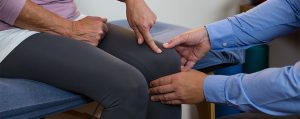Athletico Fantasy Football Injury Report 2023: Week 4
Posted on by Brandon Bowers, PT, DPT, Astym Cert.
If your fantasy football team didn’t perform as well as you hoped for in Week 3, it may be time to make some changes to your lineup!
Athletico’s Brandon Bowers, PT, DPT, Astym Cert. highlights injuries within the professional league each week in the Athletico Fantasy Football Injury Report so you know who to sit and who to start.
(more…)
Arm Care For Quarterbacks
Posted on by Mike Headtke, PTA, NASM-CES, NASM-BCS
Are you ready for some football? The Friday night lights are upon us and the excitement of getting back to playing is in the air. Have you ever wondered what it takes to truly keep your arm healthy as a quarterback? Well, today we are going to talk a little bit about that and things that you can do to help keep your arm in shape so that you can get through the season unscathed.
(more…)
Should I Exercise If My Joints Make Noise?
Posted on by Tara Hackney, PT, DPT, OCS, KTTP
Do your joints make noises when you move? Many people hear noises such as pops, creaks, or grinding in their joints, often in the knees, with activities such as going up stairs or squatting down. But it’s important to know that these noises can be normal, especially if they are not associated with any kind of pain! When joints make noise, it is commonly known as crepitus. Let’s take a closer look at what crepitus is and what you need to know in order to continue safe exercise.
(more…)
How Exercise Can Help You Connect With Your Child
Posted on by Owen Campbell, PT, DPT, OCS
Connection with your child can take many forms over the arc of parenting. From the days of dependency in early life, to watching them become their own person - parents are always searching out ways to connect with their children.
(more…)
Athletico Fantasy Football Injury Report 2023: Week 3
Posted on by Brandon Bowers, PT, DPT, Astym Cert.
As player injuries begin to have an impact on fantasy teams, Athletico’s Brandon Bowers, PT, DPT, is here to help you with your week 3 lineup in this edition of our Fantasy Football Injury Report.
In this week’s edition of the #AthleticoInjuryReport, Brandon is shedding light on injuries impacting Nick Chubb, Saquon Barkley, and Joe Burrow. Learn more by checking out the infographic below (click to enlarge):
(more…)
5 Exercises To Decrease ACL Injury Risk
Posted on by Jake Moore, PT, DPT, OCS, CSCS, CMPT
ACL injuries are one of the most impactful injuries in sports, often taking 9-12 months before an athlete can return to competition. Athletes who participate in change of direction sports such as soccer, basketball, and football tend to have the greatest risk of ACL injury.
(more…)
What Does Physical Therapy Look Like After A Fall?
Posted on by Zachary Vandenberg, DPT
Falling down at home, while shopping, or out in the community is scary, but is a very real problem that many people face. It can be embarrassing to admit or worrisome, and often people are unsure how or where to seek help. Physical therapists are trained professionals and have the ability not only to assess a person’s fall risk, but also to determine the main reasons why someone may be at risk of falling. Physical therapists also formulate a plan of action to help reduce one’s future risk of falls. This blog will walk you through different scenarios and demonstrate how physical therapy can help someone after a fall, someone who fears falling, or has been injured as a result of a fall. There will be valuable information here to explain how PT can help if you or a loved one has impaired balance, has fallen once, or has fallen multiple times.
(more…)
Self-Care for Gymnasts During Competition Season
Posted on by Tara Hackney, PT, DPT, OCS, KTTP
Gymnasts have a very long season- they usually practice year-round with the main bulk of the competition season occurring during the winter and spring for many levels. Due to this type of training schedule, gymnasts need to make sure they are taking care of themselves during and after practice. Here are some tips for self-care for gymnasts to keep them healthy and on track for a great season.
(more…)
